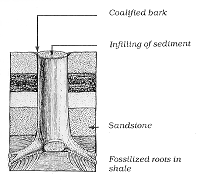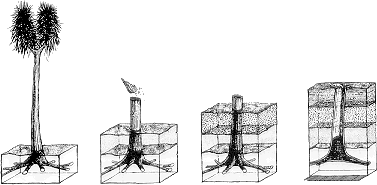Joggins Tree
 Excerpt from "The
Fossil Cliffs of Joggins" by Laing Ferguson. Excerpt from "The
Fossil Cliffs of Joggins" by Laing Ferguson.This sequence of diagrams shows how a
lycopod tree at Joggins was gradually preserved. The bottom of each stump and any
preserved roots are commonly surrounded by shale, and this is overlain by several feet of
sandstone, which surrounds the lower part of the trunk. We know that shale is formed when
mud becomes rock under pressure and that sandstone was originally sand.
 So the
sequence of sedimentary rocks we find around the base of the fossil trees at Joggins
suggests that mud was slowly deposited in the flood plain, permitting trees to become
established and grow to maturity. Then, when the river burst its banks after a heavy
rainfall, it brought in the coarser sediment from the river channel which surrounded the
tree and killed it. Later, the top of the tree was blown over by wind, leaving only a
hollow stump. The inner tissues if the stump continued to rot as sediment accumulated
around the trunk over the years. After the interior rotted and the upper part of the tree
was removed, sediment accumulated until it reached the rim of the tree, spilled into its
interior and rapidly filled it. It was at this stage, according to Dawson's theory, that
the hollow stumps acted as traps for unwary reptiles and amphibians. So the
sequence of sedimentary rocks we find around the base of the fossil trees at Joggins
suggests that mud was slowly deposited in the flood plain, permitting trees to become
established and grow to maturity. Then, when the river burst its banks after a heavy
rainfall, it brought in the coarser sediment from the river channel which surrounded the
tree and killed it. Later, the top of the tree was blown over by wind, leaving only a
hollow stump. The inner tissues if the stump continued to rot as sediment accumulated
around the trunk over the years. After the interior rotted and the upper part of the tree
was removed, sediment accumulated until it reached the rim of the tree, spilled into its
interior and rapidly filled it. It was at this stage, according to Dawson's theory, that
the hollow stumps acted as traps for unwary reptiles and amphibians.
 |
| Tree Stump Animals |
|
![]()